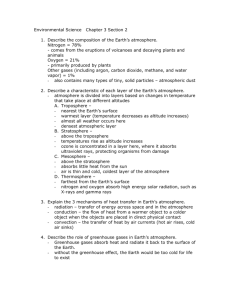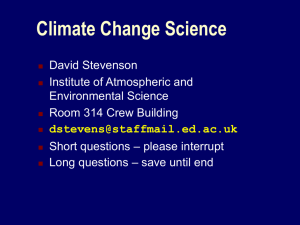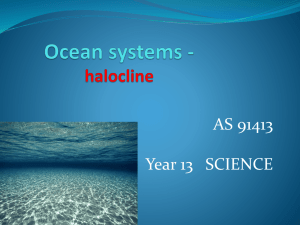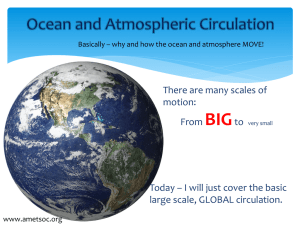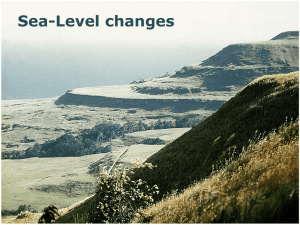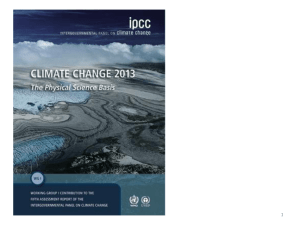Global Environmental Change Lecture Notes:
advertisement
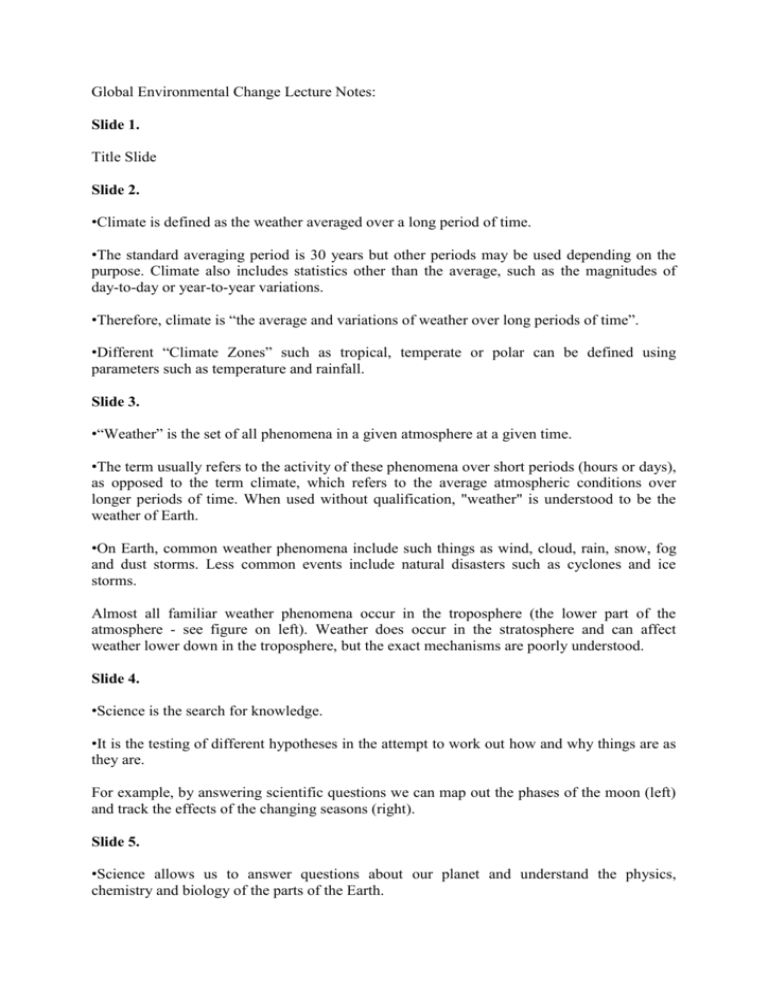
Global Environmental Change Lecture Notes: Slide 1. Title Slide Slide 2. •Climate is defined as the weather averaged over a long period of time. •The standard averaging period is 30 years but other periods may be used depending on the purpose. Climate also includes statistics other than the average, such as the magnitudes of day-to-day or year-to-year variations. •Therefore, climate is “the average and variations of weather over long periods of time”. •Different “Climate Zones” such as tropical, temperate or polar can be defined using parameters such as temperature and rainfall. Slide 3. •“Weather” is the set of all phenomena in a given atmosphere at a given time. •The term usually refers to the activity of these phenomena over short periods (hours or days), as opposed to the term climate, which refers to the average atmospheric conditions over longer periods of time. When used without qualification, "weather" is understood to be the weather of Earth. •On Earth, common weather phenomena include such things as wind, cloud, rain, snow, fog and dust storms. Less common events include natural disasters such as cyclones and ice storms. Almost all familiar weather phenomena occur in the troposphere (the lower part of the atmosphere - see figure on left). Weather does occur in the stratosphere and can affect weather lower down in the troposphere, but the exact mechanisms are poorly understood. Slide 4. •Science is the search for knowledge. •It is the testing of different hypotheses in the attempt to work out how and why things are as they are. For example, by answering scientific questions we can map out the phases of the moon (left) and track the effects of the changing seasons (right). Slide 5. •Science allows us to answer questions about our planet and understand the physics, chemistry and biology of the parts of the Earth. For example, we know how nutrients pass through ecosystems (Presenter: Briefly go through the left hand figure. Nutrients such as nitrogen are taken up from the soil by plants and consumed by animals which, when they die, pass the nutrients back into the soil via decomposers etc.). We also can track the movement of water (right hand figure) from the ocean, into the atmosphere, back onto land and once again the ocean. Science enables us to learn about the past and current ecosystems, weather patterns and climate and use this to assess any changes as we look towards the future. Slide 6. •The climate includes interaction between all areas on the surface of the Earth and in the atmosphere. •For example, water is evaporated from the ocean to form water vapor clouds in the atmosphere. The wind can then carry these clouds over the land where the water falls as rain or snow. Eventually the water may return to the ocean via rivers etc. Also, the biosphere the living plants and animals, live in and utilize the land, sea and sky - so you can see how everything is connected. Slide 7. •Atmospheric circulation is the large-scale movement of air, and the means (together with the ocean circulation, which will be discussed next) by which heat is distributed on the surface of the Earth. •The warm air found around the equator (see figure) can mix with cold air from the poles. •This air movement forms convection cells and jet streams (fast moving air currents between areas of great temperature differences) The large-scale structure of the atmospheric circulation varies from year to year, but the basic structure remains fairly constant….see next slide Slide 8. On the right (figure A) we have an idealised model of the atmospheric convection cells based on the fact that the earth is spinning and we have more sunlight and heat at the equator and less sunlight and heat at the poles. The wind belts and the jet streams circling the planet are steered by three cells: the Hadley cell (H.C. on figure), the Ferrel cell (F.C.), and the Polar cell (P.C.). The Hadley cell is the best understood. It forms a closed circulation loop, which begins at the equator with warm, moist air lifted aloft in equatorial low pressure areas to the tropopause and carried towards the pole (north pole in the northern hemisphere and south pole in the southern hemisphere). At about 30°N/S latitude, the air descends in a cooler high pressure area. Some of the descending air travels equatorially along the surface, closing the loop of the Hadley cell and creating the Trade Winds. Air movement and heat transfer on and around the land masses make some features of atmospheric circulation semi-permanent (Figure B). This is due to water having a higher specific heat capacity than land and therefore water absorbs and releases heat less readily than land. Even at microscales, this effect is noticeable; it is what causes the sea breeze, air cooled by the water, ashore in the day, and carries the land breeze, air cooled by contact with the ground, out to sea during the night. For example, the Pacific cell (see Figure B for location of high pressure regions over the Pacific ocean) is the site of the El Niño or Southern Oscillation This involves periodic pressure variations in the Indian Ocean and the Pacific ocean. Here the movement of air in these oceans affects air circulation over the adjacent land masses. Under "normal" circumstances, the weather behaves as expected (warm Summers and cool winters). But every few years, the winters become unusually warm or unusually cold, or the frequency of hurricanes increases or decreases, and the pattern sets in for an indeterminate period. This is the El Niño effect. Slide 9. •Oceanic circulation is the second way heat is distributed over the globe. This is done by surface currents and also deep global currents. Surface currents: •The ultimate reason for the world's surface ocean currents is the sun. The heating of the earth by the sun has produced semi-permanent pressure centers near the surface, as we saw in the last slide. When wind blows over the ocean around these pressure centers, surface waves are generated by transferring some of the wind's energy, in the form of momentum, from the air to the water. This constant push on the surface of the ocean is the force that forms the surface currents. •These can travel great distances. For example, in January 1992, a container ship near the International Date Line (Pacific Ocean), headed to Tacoma, Washington from Hong Kong, lost 12 containers during severe storm conditions. One of these containers held a shipment of 29,000 bathtub toys. Ten months later, the first of these plastic toys began to wash up onto the coast of Alaska. Driven by the wind and ocean currents, these toys continue to wash ashore during the next several years and some even drifted into the Atlantic Ocean. Deep currents: •There is also global circulation, which extends to the depths of the sea called the Great Ocean Conveyor. Also called the thermohaline circulation, as it is driven by differences in the density of the seawater, which is controlled by temperature (thermal) and salinity (haline). •In the northern Atlantic Ocean, as water flows north it cools considerably increasing its density. As it cools to the freezing point, sea ice forms with the "salts" extracted from the frozen water making the water below more dense. The very salty water sinks to the ocean floor. •It is not static, but a slowly southward flowing current. The route of the deep water flow is through the Atlantic Basin around South Africa and into the Indian Ocean and on past Australia into the Pacific Ocean Basin. •If the water is sinking in the North Atlantic Ocean then it must rise somewhere else. This upwelling is relatively widepsread. However, water samples taken around the world indicate that most of the upwelling takes place in the North Pacific Ocean. •It is estimated that once the water sinks in the North Atlantic Ocean that it takes 1,000-1,200 years before that deep, salty bottom water rises to the upper levels of the ocean. Slide 10. •The atmospheric composition on Earth is largely governed by the by-products of the life that it sustains. •Earth's atmosphere consists principally of a roughly 78:20 ratio of nitrogen and oxygen, plus substantial water vapor (gas), with a minor proportion of carbon dioxide. There are traces of hydrogen, and of argon, helium and other "noble" gases (and of volatile pollutants). The role of the Earth’s atmosphere is varied. •It’s the environment for most of its biological activity • The atmosphere (as we have seen) exerts considerable influence on the weather and climate and also ocean circulation. •The atmosphere protects earth's life forms from harmful radiation and cosmic debris. •The ozone layer within the atmosphere also protects the earth from the sun's harmful ultraviolet rays. •The atmosphere, more specifically the thermosphere and mesosphere cause meteors that hit it to burn up from the heat generated by air friction. •Importantly, if the Earth did not have an atmosphere the average global temperature would be 30 degrees Celsius below what it is today! (Presenter: this leads into the next slide on the Greenhouse Effect….) Slide 11. •The Earth receives energy from the Sun in the form of radiation. •The Earth reflects about 30% of the incoming solar radiation. The remaining 70% is absorbed, warming the land, atmosphere and oceans. •For the Earth's temperature to be in equilibrium so that the Earth does not rapidly heat or cool, this absorbed solar radiation must be very nearly balanced by energy radiated back to space in the infrared wavelengths. •The figure on the left shows the absorption bands in the Earth's atmosphere (middle panel), I.e. the wavelength spectrum (UV, IR, visible light) that is absorbed by the atmosphere, and the effect that this has on both solar radiation (energy from the sun) and upgoing thermal radiation (energy reflected from the Earth) (top panel). •Individual absorption spectrum for major greenhouse gases are also shown. •You can see that high amounts of UV and IR wavelengths from the sun are absorbed by the atmosphere, whereas much of the visible light spectrum passes through (allowing us to see!). Of the up-going thermal radiation (blue) a budget of IR wavelengths pass through the atmosphere to be lost to space. •The figure on the right is a simplified, schematic representation of the flows of energy between space, the atmosphere, and the Earth's surface, showing how these flows combine to trap heat near the surface and create the greenhouse effect. •Energy exchanges are expressed in watts per square meter (W/m2); values from Kiehl and Trenberth (1997). •The sun provides an annual average of ~235 W/m2 of energy to the Earth’s surface. If this were the total heat received at the surface, then we would be expect to have an average global temperature of -18°C. Instead, the Earth's atmosphere recycles heat coming from the surface and delivers an additional 324 W/m2, which results in an average surface temperature of roughly +14 ° C. •Of the surface heat captured by the atmosphere, more than 75% can be attributed to the action of greenhouse gases (carbon dioxide, methane, nitrous oxide etc.) that absorb thermal radiation (the up-going energy emitted by the Earth's surface). •The atmosphere in turn transfers the energy it receives both into space (38%) and back to the Earth's surface (62%), where the amount transferred in each direction depends on the thermal and density structure of the atmosphere. •This process by which energy is recycled in the atmosphere to warm the Earth's surface is known as the greenhouse effect and is an essential piece of Earth's climate. •Under stable conditions, the total amount of energy entering the system from solar radiation will be exactly the same as the amount being radiated into space, thus allowing the Earth maintain a constant average temperature over time. However, recent measurements indicate that the Earth is presently absorbing 0.85 - 0.15 W/m2 more than it emits into space (Hansen et al. 2005). This increase, associated with global warming, is believed to have been caused by the recent increase in greenhouse gas concentrations. References: •Kiehl, J. T. and Trenberth, K. E. (1997). "Earth's Annual Global Mean Energy Budget". Bulletin of the American Meteorological Association 78: 197-208. •Hansen, J., et al. (2005). "Earth's Energy Imbalance: Confirmation and Implications". Science 308 (5727): 1431-1435. Slide 12. We know a lot about the modern climate systems and the effects we witness today. However, if we want to know if the climate is changing we need to know what it was like in the past…. How do we learn what the past climate was like? Slide 13. •A record of past local environmental conditions may be preserved in early rock art and sculpture. •For example, rock paintings from Tassili N´Ajjer in Algeria show that the region in Neolithic times was moist and fertile, with abundant water and wildlife. The art depicts herds of cattle, large wild animals including crocodiles, and human activities such as hunting and dancing. •This area now hosts a sandstone mountain range located in a desert. More than 15,000 drawings and engravings record the climatic changes, the animal migrations and the evolution of human life on the edge of the Sahara from 6000 B.C. to the first centuries of the present era. Slide 14. •Geomorphology is the study of landforms, including their origin and evolution, and the processes that shape them. •Studying of surface features such as valleys, mountains, river beds, ancient dune and lake deposits can tell you what the environment was like in the past. •For example, the Lake District in North West England has many valleys shaped like a “U”. They have flat bottoms and steep sides. (As opposed to River Valleys that are typically “V” shaped). These were formed by the passage of glaciers that carved their way through the landscape. There are no glaciers there today but from the physical features they left behind we can tell that the area was once covered in ice. Slide 15. •The Geological record can tell us a lot about past climates. •Fossils of plants and animals can provide evidence of what the past ecosystem was like. •For example, fossils of plants and animals in Antarctica show that during the Cambrian period Antarctica had a mild climate. West Antarctica was partially in the northern hemisphere, and East Antarctica was at the equator, where sea-floor invertebrates and trilobites flourished in the tropical seas •Fossils also show that during the Mesozoic era (250-65 Mya), as a result of continued warming, the polar ice caps melted and the Antarctic Peninsula began to form. Ginkgo trees and cycads were plentiful during this period, as were large reptiles and dinosaurs, though only two Antarctic dinosaur species have been described to date. •Sediments are a good record of past environments. They can tell a geologist what type of environment deposited them, e.g. a beach, river, desert, ocean etc. And fossils preserved in the sediments will provide information about the biota. To sample sedimentary layers deep in the Earth scientists often have to drill for them. The right hand photos show an example of drill core recovered from the ocean floor in the Caribbean. Each dark and light layers represents progressively older sedimentary layers. Slide 16. •An ice core is a core sample from the accumulation of snow and ice over many years that have recrystallised and have trapped air bubbles from previous time periods. The composition of these ice cores, especially the presence of hydrogen and oxygen isotopes, provides scientists with a picture of the climate at the time. •Water molecules containing heavier isotopes exhibit a lower vapor pressure, when the temperature falls, the heavier water molecules will condense faster than the normal water molecules. The relative concentrations of the heavier isotopes in the condensate indicate the temperature of condensation at the time, allowing for ice cores to be used in global temperature reconstruction, I.e. by measuring the isotope ratios of the frozen water in the ice cores scientists can reconstruct what the temperature was when the water was frozen •In addition to the isotope concentration, the air bubbles trapped in the ice cores allow for measurement of the atmospheric concentrations of trace gases, including greenhouse gases carbon dioxide, methane, and nitrous oxide. •The bottom photograph shows a section of the GISP2 ice core from 1837-1838 meters in which annual layers are clearly visible. The appearance of the dark and light layers results from differences in the size of snow crystals deposited in winter versus summer and resulting variations in the abundance and size of air bubbles trapped in the ice. Counting such layers has been used (in combination with other techniques) to reliably determine the age of the ice. In this case the ice was formed ~16250 years ago during the final stages of the last ice age and approximately 38 years are represented in the photo. •Therefore, by analyzing the ice and the gases trapped within, scientists are able to learn about past climate conditions. Slide 17. Presenter: Open the class up for discussion on ways we can help the environment. We have most likely all heard that the climate is getting warmer and areas of the globe are having more “intense” weather systems, e.g. drought in Australia, fires in California, Hurricane in New Orleans, Earthquake and Tsunami in Indonesia etc. Has Britain’s weather changed? Has anyone noticed any local effects? E.g. Spring coming early, unusually wet Summer/dry Winter, flowers blooming early, etc. Exercise: Divide the class into an appropriate number of groups. Get each group to discuss the environment and climate change. The task is to write down as many ways to save energy and become “greener” the students can think of. Get one member of each group to present their ideas. See which group comes up with the most ideas. For example, recycle (glass, plastic, aluminium, garden waste/compost, food waste etc.), turn off lights and appliances when not in use (don’t just use the “stand by” button), low energy light bulbs, shorter showers, turn down (or off) heating, recycle “grey” water (collect the rise water from you washing machine to use on your garden), install solar panels, water tanks, grow your own food (fruit, vegetables), don’t by food with excess packaging, walk or ride a bike instead of taking a vehicle, use public transport, carpool etc. - I’m sure the class can think of many different things! Slide 18. In the following section we will discuss the past and current trends in climate change and use these models to look towards the future. Slide 19. •Climate change refers to the variation in the Earth's global climate or in regional climates over time. • It describes changes in the variability or average state of the atmosphere over time scales ranging from decades to millions of years. These changes can be caused by processes internal to the Earth, external forces (e.g. variations in sunlight intensity) or, more recently, human activities. Slide 20. •Geologically recent trends in climate show an increase in global temperatures. •This figure shows the change in temperature over the past 150 years based on measurements compiled by the Climatic Research Unit of the University of East Anglia and the Hadley Centre of the UK Meteorological Office. •The “zero” point on this figure is the mean temperature from 1961-1990. The results show a general temperature increase of 0.57 +/- 0.17°C. Slide 21. •If you put the data on the last slide onto a map to plot where the temperature changes are occurring, you get the above figure. Note: Some parts of Antarctica have become colder. Whereas the majority of the northern hemisphere is warmer. On average the UK has become 1°C hotter. Slide 22. •This image is a comparison of 10 different published reconstructions of mean temperature changes during the last 1000 years (see references below). •The medieval warm period and little ice age are labeled at roughly the times when they are historically believed to occur, though it is still disputed whether these were truly global or only regional events. •Although each of the curves is slightly different, we can see a general trend of decreasing temperature (into the Little Ice Age) until around 1850-1900. At this point there is a sharp increase in temperature until the dataset stops at 2004. •The largest increase in recent years corresponds to the onset of the Industrial Revolution and consequently the anthropogenic (human) input of greenhouse gases into the environment. References: •The reconstructions used, in order from oldest to most recent publication are: 1.(dark blue 1000-1991): Jones, P.D., K.R. Briffa, T.P. Barnett, and S.F.B. Tett (1998). "High-resolution Palaeoclimatic Records for the last Millennium: Interpretation, Integration and Comparison with General Circulation Model Control-run Temperatures". The Holocene 8: 455-471. 2.(blue 1000-1980): Mann, M.E., R.S. Bradley, and M.K. Hughes (1999). "Northern Hemisphere Temperatures During the Past Millennium: Inferences, Uncertainties, and Limitations". Geophysical Research Letters 26 (6): 759-762. 3. (light blue 1000-1965): Crowley, Thomas J. and Thomas S. Lowery (2000). "Northern Hemisphere Temperature Reconstruction". Ambio 29: 51-54.ハ; Modified as published in Crowley (2000). "Causes of Climate Change Over the Past 1000 Years". Science 289: 270277. 4. (lightest blue 1402-1960): Briffa, K.R., T.J. Osborn, F.H. Schweingruber, I.C. Harris, P.D. Jones, S.G. Shiyatov, and E.A. Vaganov (2001). "Low-frequency temperature variations from a northern tree-ring density network". J. Geophys. Res. 106: 2929-2941. 5. (light green 831-1992): Esper, J., E.R. Cook, and F.H. Schweingruber (2002). "LowFrequency Signals in Long Tree-Ring Chronologies for Reconstructing Past Temperature Variability". Science 295 (5563): 2250-2253. 6. (yellow 200-1980): Mann, M.E. and P.D. Jones (2003). "Global Surface Temperatures over the Past Two Millennia". Geophysical Research Letters 30 (15): 1820. 7. (orange 200-1995): Jones, P.D. and M.E. Mann (2004). "Climate Over Past Millennia". Reviews of Geophysics 42: RG2002. 8. (red-orange 1500-1980): Huang, S. (2004). "Merging Information from Different Resources for New Insights into Climate Change in the Past and Future". Geophys. Res Lett. 31: L13205. 9. (red 1-1979): Moberg, A., D.M. Sonechkin, K. Holmgren, N.M. Datsenko and W. Karl (2005). "Highly variable Northern Hemisphere temperatures reconstructed from low- and high-resolution proxy data". Nature 443: 613-617. 10. (dark red 1600-1990): Oerlemans, J.H. (2005). "Extracting a Climate Signal from 169 Glacier Records". Science 308: 675-677 (black 1856-2004): Instrumental data was jointly compiled by the Climatic Research Unit and the UK Meteorological Office Hadley Centre. Global Annual Average data set TaveGL2v was used. Documentation for the most recent update of the CRU/Hadley instrumental data set appears in: Jones, P.D. and A. Moberg (2003). "Hemispheric and large-scale surface air temperature variations: An extensive revision and an update to 2001". Journal of Climate 16: 206-223. Slide 23. •This figure shows the Antarctic temperature changes during the last several glacial/interglacial cycles of the present ice age and a comparison to changes in global ice volume. •The present day is on the right (zero at the horizontal scale). •The top two curves shows local changes in temperature at two sites in Antarctica as derived from deuterium isotopic measurements (δD) on ice cores. •The bottom plot shows a reconstruction of global ice volume based on δ18O measurements on benthic foraminifera from a composite of globally distributed sediment cores and is scaled to match the scale of fluctuations in Antarctic temperature (Lisiecki and Raymo 2005). •Note that changes in global ice volume and changes in Antarctic temperature are highly correlated, so one is a good estimate of the other, but differences in the sediment record do no necessarily reflect differences in paleotemperature. •Horizontal lines indicate modern temperatures and ice volume. So we can see that over the last 450,000 years there have been multiple cycles of high and low temperatures and multiple events where the ice sheets in Antarctica have melted and re-formed. •We are currently in a period where the temperatures are high and the ice volumes are low (see vertical scales on right hand side). •These Antarctic temperature records indicate that the present interglacial (Meaning: globally warm time periods in between ice ages) is relatively cool compared to previous interglacials, at least at these sites (see high temperature peaks in the top two graphs). •It is believed that the interglacials themselves are triggered by changes in Earth's orbit known as Milankovitch cycles and that the variations in individual interglacials can be partially explained by differences within this process. For example, Overpeck et al. (2006) argues that the previous interglacial was warmer because of increased solar radiation at high latitudes. References: •Lisiecki, L. E., and M. E. Raymo (2005). "A Pliocene-Pleistocene stack of 57 globally distributed benthic δ18O records". Paleoceanography 20: PA1003. •Overpeck, Jonathan T., Bette L. Otto-Bliesner, Gifford H. Miller, Daniel R. Muhs, Richard B. Alley, Jeffrey T. Kiehl (2006). "Paleoclimatic Evidence for Future Ice-Sheet Instability and Rapid Sea-Level Rise". Science 311 (5768): 1747-1750. Slide 24. •This figure shows the long-term evolution of oxygen isotope ratios during the Phanerozoic eon as measured in fossils (Veizer et al., 1999). •Difference in oxygen isotope ratios reflect both the local temperature at the site of deposition (different isotopes are preferentially preserved at different temperatures. Measuring these provides a record of the temperature the material was deposited at) and global changes associated with the extent of continental glaciation. As such, relative changes in oxygen isotope ratios can be interpreted as rough changes in climate. •We see that there has been multiple cycles of glaciation and global warming throughout the Earth’s history. •Currently we should be entering a “cold” period of glaciation if these trends continue. •The questions are: have we reached the lowest temperature of the natural cycle and therefore the global warming we are experiencing is the “normal” warming part of the cycle (the upward trend of the curve on the graph)? Or has human activity significantly influenced the natural cycle, thereby causing the temperature to rise prematurely? References: •Veizer, J., Ala, D., Azmy, K., Bruckschen, P., Buhl, D., Bruhn, F., Carden, G.A.F., Diener, A., Ebneth, S., Godderis, Y., Jasper, T., Korte, C., Pawellek, F., Podlaha, O. and Strauss, H. (1999). "87Sr/86Sr, δ13C and δ18O evolution of Phanerozoic seawater". Chemical Geology 161: 59-88. Slide 25. •Anthropogenic factors are acts by humans that change the environment and influence climate. •Various theories of human-induced climate change have been debated for many years. •The biggest factor of present concern is the increase in CO2 levels due to emissions from fossil fuel combustion, followed by aerosols (particulate matter in the atmosphere) which exerts a cooling effect and cement manufacture. Other factors, including land use, ozone depletion, animal agriculture and deforestation also affect climate. Fossil Fuels: •Beginning with the industrial revolution in the 1850s and accelerating ever since, the human consumption of fossil fuels has elevated CO2 levels from a concentration of ~280 ppm (parts per million) in the atmosphere to more than 380 ppm today. •These increases are projected to reach more than 560 ppm before the end of the 21st century. It is known that carbon dioxide levels are substantially higher now than at any time in the last 800,000 years (see graph on right hand side: current levels of CO2 exceed any previous natural levels). Along with rising methane levels, these changes are anticipated to cause an increase of 1.4-5.6°C between 1990 and 2100. Aerosols: •Anthropogenic aerosols, particularly sulphate aerosols from fossil fuel combustion, are believed to exert a cooling influence. This, together with natural variability, is believed to account for the relative "plateau" in the graph of 20th century temperatures in the middle of the century. Cement Manufacture: •Cement manufacturing is the third largest cause of man-made carbon dioxide emissions. While fossil fuel combustion and deforestation each produce significantly more carbon dioxide (CO2), cement-making is responsible for approximately 2.5% of total worldwide emissions from industrial sources (energy plus manufacturing sectors). Land Use: •Prior to widespread fossil fuel use, humanity's largest effect on local climate is likely to have resulted from land use. For example, irrigation, deforestation, and agriculture change the amount of water going into and out of a given location. Livestock: •According to a 2006 United Nations report, livestock is responsible for 18% of the world’s greenhouse gas emissions as measured in CO2 equivalents. •This however includes land usage change, meaning deforestation in order to create grazing land. In the Amazon, 70% of deforestation is to make way for grazing land, so this is the major factor in the 2006 UN FAO report, which was the first agricultural report to include land usage change into the radiative forcing of livestock. In addition to CO2 emissions, livestock produces 65% of human-induced nitrous oxide (which has 296 times the global warming potential of CO2) and 37% of human-induced methane (which has 23 times the global warming potential of CO2). Slide 26. •This figure shows the predicted distribution of temperature change due to global warming from the Hadley Centre HadCM3 climate model. •These changes are based on the IS92a ("business as usual") projections of carbon dioxide and other greenhouse gas emissions during the next century, and essentially assume normal levels of economic growth and no significant steps are taken to combat global greenhouse gas emissions. •The plotted colors show predicted surface temperature changes expressed as the average prediction for 2070-2100 relative to the model's baseline temperatures in 1960-1990. •The average change is 3.0°C, placing this model on the lower half of the Intergovernmental Panel on Climate Change's 1.4-5.8°C predicted climate change from 1990 to 2100. •As can be expected from their lower specific heat, continents are expected to warm more rapidly than oceans with an average of 4.2°C and 2.5°C in this model respectively. The lowest predicted warming is 0.55°C south of South America and the highest is 9.2°C in the Arctic Ocean (points exceeding 8°C are plotted as black). •Note the large increase in temperature over the South American continent. A result of the loss of the Brazilian rainforest. Slide 27. •An increase in global temperatures is expected to cause other changes, including sea level rise, increased intensity of extreme weather events, and changes in the amount and pattern of precipitation. •For example, sea level rise: With increasing average global temperature, the water in the oceans expands in volume, and additional water enters them which had previously been locked up on land in glaciers, for example, the Greenland and the Antarctic ice sheets. An increase of 1.5 to 4.5°C is estimated to lead to an increase of 15 to 95 cm (IPCC 2001).The sea level has risen more than 120m since the peak of the last ice age about 18,000 years ago! The bulk of that occurred before 6000 years ago. From 3000 years ago to the start of the 19th century, sea level was almost constant, rising at 0.1 to 0.2 mm/yr; since 1900, the level has risen at 1-2 mm/yr; since 1992, satellite altimetry indicates a rate of about 3 mm/yr! (See graph for the change in sea level over time). •Other effects of global warming include changes in agricultural yields, glacier retreat, species extinctions and increases in the ranges of disease vectors (carriers). •Remaining scientific uncertainties include the amount of warming expected in the future, and how warming and related changes will vary from region to region around the globe. There is ongoing political and public debate worldwide regarding what, if any, action should be taken to reduce or reverse future warming or to adapt to its expected consequences. Most national governments have signed and ratified the Kyoto Protocol, aimed at reducing greenhouse gas emissions. Slide 28. Presenter: read through questions as they appear one by one…these are the hot topics of debate at the moment. We know from studying the past climate cycles that humans are having an influence on the current conditions. Scientists have identified these questions as important but we don’t yet know what the future effects will be. Slide 29. Presenter: Refer to the ideas the students suggested during the exercise….
